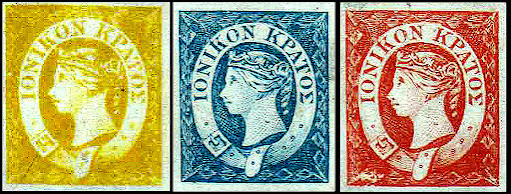It was decided to avoid denominations altogether and code the rates by color.
The genuine orange stamps don't have a watermark, the blue stamp has a '2' (this stamp was originally intended to serve as a 2 d stamp) and the red stamp has a watermark '1' (this stamp was intended to serve as a 1 d stamp first)
All three stamps were printed from the same plate, with only a change in color.
50,000 sets were recess printed by Perkins, Bacon & Co and they went on sale on June 15, 1859.
Charles H. Jeens engraved the queen's head after a Henry Corbould drawing.
A Corbould drawing also was the inspiration for the Penny Black.
Genuinely cancelled stamps are very scarce, so forged cancellations abound.
On June 28, 1864 Greece took possession of the islands, invalidating the Ionian Islands stamps and putting Greek stamp use in their place.
Genuine stamps
 |
Forgeries
The original source of these forgeries is very much in doubt.
Fournier, Spiro, Panelli, Oneglia, Torres and others produced or sold these but there was obvious interaction
between them.
Most forgeries display characteristics of other forgeries which may in part be due to copying other forgeries rather
than the rare originals.
So, as a guide I am presenting groups (in no particular order) that have similar characteristics.
Fournier, Spiro, Panelli, Oneglia, Torres and others produced or sold these but there was obvious interaction
between them.
Most forgeries display characteristics of other forgeries which may in part be due to copying other forgeries rather
than the rare originals.
So, as a guide I am presenting groups (in no particular order) that have similar characteristics.
Type I
Queen has thick eyebrow and pointed noseLarge top hole in the end of the belt
The KP is joined
The right leg of the first K is lacking a complete serif
The top right of the N is curved
Type II
The key feature is the poorly designed eyeThe right side of the last letter is too long and the left side lacks the extended serif
There is only one hole on the right of the buckle instead of 2
Type III
The queen has a staring vacant look
The top right leg of the K's are too long
The top right leg of the K's are too long
Type IV
The top hole at the end of the belt is large
The KP is joined
The left side of the last letter is distorted
The KP is joined
The left side of the last letter is distorted
Type V
The queen has a curved pointed nose
The eyes are piercing and heavily shaded
The buckle is smaller
The O's are smaller
The P has a short leg
The cancel that appears on others of this set is a typical B62 Hong Kong cancel
The eyes are piercing and heavily shaded
The buckle is smaller
The O's are smaller
The P has a short leg
The cancel that appears on others of this set is a typical B62 Hong Kong cancel
Type VI
Overall these are very well made
They may be from Oneglia or Panelli
They can be found with very large margins - these images were cropped
The key feature is the last letter which is tilted
They may be from Oneglia or Panelli
They can be found with very large margins - these images were cropped
The key feature is the last letter which is tilted
Type VII
Fournier forgeries
It is well accepted that Fournier sold forgeries produced by others
These sheets from the Geneva Fournier collection are identical to the Type V above
Type VIII
Type IX















